This weekend will see the first race of the Group 5 series at the track. This is the second time this series has been run at the track with the first series being 2013 with eight racers fighting for the top of the podium.
One of the best things about this race is the option for the racers to run a Racer Sideways model (basically Racer plastic body with all Slot It internals) making it easy for any racer to purchase a car, do some simple modifications and have a race winner. You could also use your car building skills to build a custom car using any Group 5 body mated to any plastic chassis you can get to work.
Here is a picture of the eight cars that competed in the first Group 5 series in 2013. Four of these cars are Racer Sideways and four are custom.

Here is a picture of the bottom of all the cars and what the different set ups looked like in 2013. As you can see there are many different set ups and many different ways to build a winner.
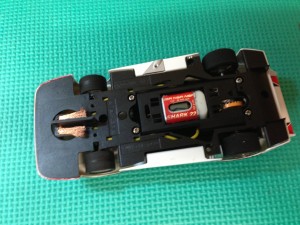

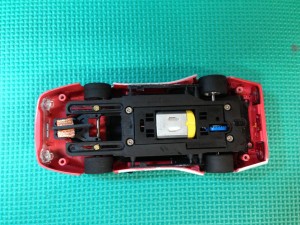
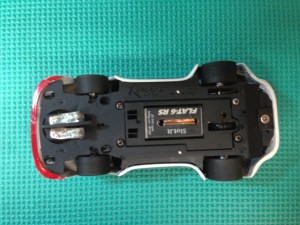
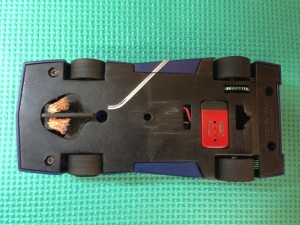

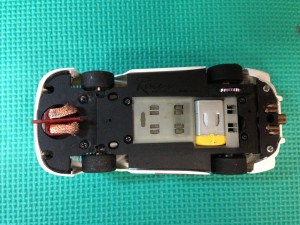
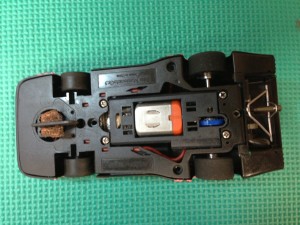
Good luck to everyone competing in this race series.
Rules for 2015 Group 5.
Models Allowed
- Porsche 935 (includes the 935-77, 935-78 known as the Moby-Dick and the customer Kremer K3 and K4 and the JLP variation)
- BMW 320i Turbo
- Toyota Celica LB Turbo (RA22) (1st generation)
- Dome Celica Turbo (RA45) (2nd generation)
- TOM’S Corolla G5 (A40)
- Nissan Skyline RS Silhouette Formula
- Nissan Nichira Impul Silvia (two nose variations)
- Mazda RX-7 252i
- Mazda RX-7 253/253i/253SR
- Mazda RX-7 254/254i
- Nissan Bluebird SSS Turbo
- BMW 3.0 CSL
- BMW M1
- Lancia Stratos Turbo
- Lancia Beta Montecarlo Turbo
- Ferrari 512BB LM
- Zakspeed Ford Capri Turbo
- Ford Escort Zakspeed
- Zakspeed Lotus Europa Gr.5
- Greenwood Widebody Corvette
Body and Chassis
- 1.1: Chassis and body do not have to be naturally mated RTR set from the same manufacturer. Podded & universal chassis are allowed. Chassis may be braced, reinforced or strengthened. Minor trimming is allowed for body float. Body screws should be taped to prevent loss.
- 1.2: Chassis may be modified to accept front axle mounts (SCC) or guide modifiers (B-NOVA).
- 1.3: Guide may not project beyond the body when aligned for straight, as viewed from directly above.
- 1.4: Cars must have sufficient ground clearance to permit free running without contacting the track. Cars which drag on the track may be excluded at the track owners’ discretion.
- 1.5: Clear window material must be used where the real car has clear material.
- 1.6: Racing numbers must be visible in three places on body. Racing numbers must match. Bodies may be painted in fantasy or realistic liveries. Non-decorated cars (for example plain white kits) are not allowed.
- 1.7: Body (including interior) minimum weight is 20 grams. Interior must include, at minimum, dashboard top. Rear shelf is required under rear window, if car has a rear window. Driver figure must be included. If vacuum formed, must be of reasonable detail and proportion. Champion style and paper drivers are not permitted.
- 1.8: Maximum weight limit is 105 Gm. Minimum weight limit is 70 Gm. Maximum width is 2.60″ (62mm).
Wheels and Tires
- 2.1: Tires may not project beyond the body when the car is at rest on a level track, as viewed from directly above.
- 2.2: Reasonable scale appearing inserts are required in all wheels, unless the wheels have scale appearance and detail. Blank disc wheels, and wheels pierced with simple holes, must be covered with inserts.
- 2.3: Minimum wheel size is nominal 15mm diameter over center-rib, or a scale 16″ (.500″) diameter over visible part of rim with tire mounted (simulating a nominal 15″ wheel), unless actual car raced with smaller wheels. F1 style wheels are not allowed, unless the actual car raced with 13″-14″ nominal diameter rims.
- 2.4: Minimum front tire width is 8mm. Front tires may be profiled so that a narrower area contacts the track, but must otherwise be full width.
- 2.5: Maximum rear tire width is 11mm.
- 2.6: Front tires may be of any rubber/urethane compound. Silicon tires are expressly forbidden. Tires must appear to be black. Clear finish may be applied to tire tread area.
- 2.7: No chemical treatment (such as oil soaking) is permitted.
Motors
- 3.1: Any commercially available, up to 30K RPM at 12 volts, sealed-can slot car motor is allowed. No rewinds or “mod motors” allowed.
- 3.2: Magnetic down force from motor may not exceed 30 grams as checked with a Magnet Marshal, exclusive of car weight.
- 3.3: Motor can be glued/taped/screwed in place. Pods can be taped or glued to restrict movement.
Modifications
- 4.1: Wheels, tires, gears, axles, guides, braids, wires, and bearings may be modified or replaced by any manufacturer’s parts that are readily available to all competitors. All-wheel drive, and multiple motors, may be used only if the actual car used them.
- 4.2: Weight/ballast can be added to the car but must be contained on the inside of the body.
- 4.3: Spring and magnetic suspension packages are allowed.
- 4.4: No traction magnets allowed.
Track Power
The series will be raced at 11 Volts.
General
If it is not mentioned it is not legal.
These rules were written to create a fair event and not for racers to look for loopholes.

Marty, great photos. I don’t even remember you taking photos of the bottom of the cars.